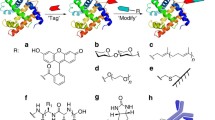Abstract
In the study of chemical modification of enzymes and other biologically active proteins, plots of fractional residual activity as a function of number of groups modified per enzyme molecule are often used to establish a correlation between the chemical modification and enzyme inactivation reactions and to determine the stoichiometry of the modification reaction. This paper presents a critical examination of the underlying theoretical framework of such graphs. Whereas these plots are usually presented as linear functions, it is shown here that the general equation describing the relationship between inactivation and modification contains an exponential term; therefore, in the general case, the plot is actually a curve. It is suggested that caution be exercised in the interpretation of such plots and that equations such as those derived in the text be used to fit theoretical curves to the data, in order to maximize the information gained from chemical modification experiments.
Similar content being viewed by others
Literature
Berghäuser, J. 1975. “A reactive arginine in adenylate kinase.”Biochim. biophys. Acta 397, 370–376.
Foster, M. and J. H. Harrison. 1974. “Selective chemical modification of arginine residues in mitochondrial malate dehydrogenase.”Biochem. biophys. Res. Commun. 58, 263–267.
Glazer, A. N., R. J. De Lange and D. S. Sigman. 1975.Chemical Modification of Proteins: Selected Methods and Analytical Procedures. Amsterdam, North-Holland.
Kantrowitz, E. R. and W. N. Lipscomb. 1976. “An essential arginine residue at the active site of aspartate transcarbamylase.”J. biol. Chem. 251, 2688–2695.
Levy, H. M., P. D. Leber and E. M. Ryan. 1963. “Inactivation of myosin by 2,4-dinitrophenol and protection by adenosine triphosphate and other phosphate compounds.”J. biol. Chem. 238, 3654–3659.
Levy, R. H., J. Ingulli and A. Afolayan. 1977. “Identification of essential arginine residues in glucose-6-phosphate dehydrogenase fromLeuconostoc mesenteroides.”J. biol. Chem. 252, 3745–3751.
Means, G. E. and R. E. Feeney. 1971.Chemical Modification of Proteins. San Francisco: Holden-Day.
Paterson, A. K. and J. R. Knowles. 1972. “The number of catalytically essential carboxyl groups in pepsin.”Eur. J. Biochem. 31, 510–517.
Rakitzis, E. T. 1977. “Kinetics of irreversible enzyme inhibition: co-operative effects.”J. theor. Biol. 67, 49–59.
Rakitzis, E. T. 1978. “Kinetics of irreversible enzyme inhibition: the Tsou plot in irreversible binding co-operativity.”J. theor. Biol. 70, 461–465.
Ray, W. J. and D. E. Koshland. 1961. “A method for characterizing the type and numbers of groups involved in enzyme action.”J. biol. Chem. 236, 1973–1979.
Ray, W. J. and D. E. Koshland. 1962. “Identification of amino acids involved in phosphoglucomutase action.”J. biol. Chem. 237, 2493–2505.
Roberts, M. F. and R. L. Switzer. 1978. “Inactivation ofSalmonella phosphoribosylpyrophosphate synthetase by specific chemical modification of a lysine residue.”Arch. Biochem. Biophys. 185, 391–399.
Singer, S. J. 1967. “Covalent labeling of active sites.”Adv. Protein Chem. 22, 1–51.
Soon, C. Y., M. G. Shepherd and P. A. Sullivan. 1978. “Inactivation and modification of lactate oxidase with fluorodinitrobenzene.”Biochem. J. 173, 255–262.
Tsou, C.-L. 1962.Scientia Sin. 11, 1535–1558.
Author information
Authors and Affiliations
Rights and permissions
About this article
Cite this article
Stevens, E., Colman, R.F. Chemical modification of enzymes: Critical evaluation of the graphical correlation between residual enzyme activity and number of groups modified. Bltn Mathcal Biology 42, 239–255 (1980). https://doi.org/10.1007/BF02464640
Received:
Issue Date:
DOI: https://doi.org/10.1007/BF02464640




